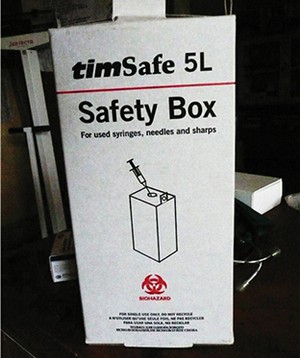- Waste disposal facilities such as an incinerator and burial pits must be available, appropriate for the type of waste and health services provided. (Disposal is described further in the next section.)
- Water supply and handwashing facilities are very important for good personal hygiene practice among health workers and patients. In addition, all staff who handle or come in contact with the waste should be provided with appropriate protective clothing including gloves, aprons and face masks.

Figure 12.4 Safety box for collecting needles and other sharps.
Disposal of healthcare waste
In large cities, it may be possible for healthcare waste to be collected and taken for disposal off-site by a licensed disposal firm. However, in smaller towns and cities each healthcare facility will probably have to dispose of its own waste. The two main methods are burial or incineration (described in Study Session 10).
A number of separate pits will be needed for the different types of hazardous healthcare waste. For anatomical and pathological wastes, a placenta pit should be used. These should be sited inside the health facility compound and be at least 1 m deep. The pit should be fenced and have a locked gate. The waste should be collected in a plastic or galvanised metal container with a tight-fitting cover and immediately transported to the pit using dedicated trolleys or carts. The waste should be covered with a layer of soil immediately after disposal into the pit. Care needs to be taken over the disposal of anatomical waste that consists of identifiable body parts. Burial is the best way of disposing of these wastes, but local customs and cultures of the society must be taken into account.
Sharps and the remains of incinerated sharps safety boxes should be disposed of in a sharps pit. A properly constructed sharps pit should have a cover at the surface and be lined with concrete to make it watertight in order to avoid contamination of groundwater and soil.
Incinerators can be used to treat some hazardous healthcare wastes. If the incineration process takes place at a sufficiently high temperature, it can be an effective way of destroying pathogens and sterilising sharps, but should not be used for anatomical wastes for which a purpose-designed incinerator should be used. However, you should note that incinerators are only likely to be available in the larger health facilities in major cities and towns. The ash removed from an incinerator should be buried in an ash pit.
All burial pits for hazardous waste should be properly fenced to prevent access by people or animals. The bottom of the pit must be at least 1.5 m above the water table to prevent groundwater contamination.